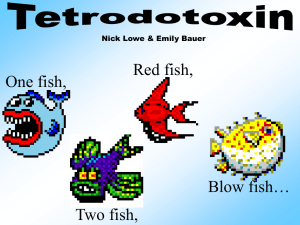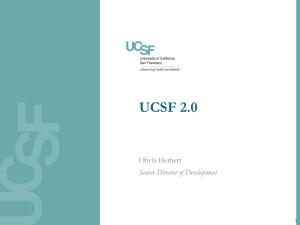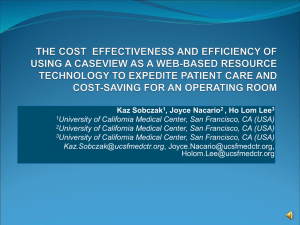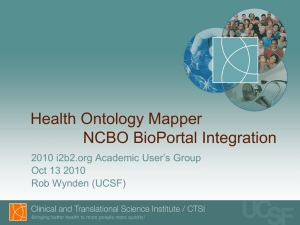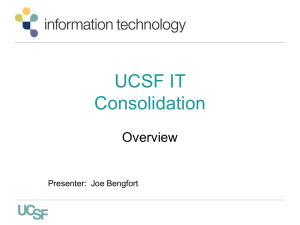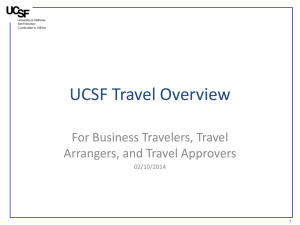Tetrodotoxin - UCSF Occupational Health Program
advertisement
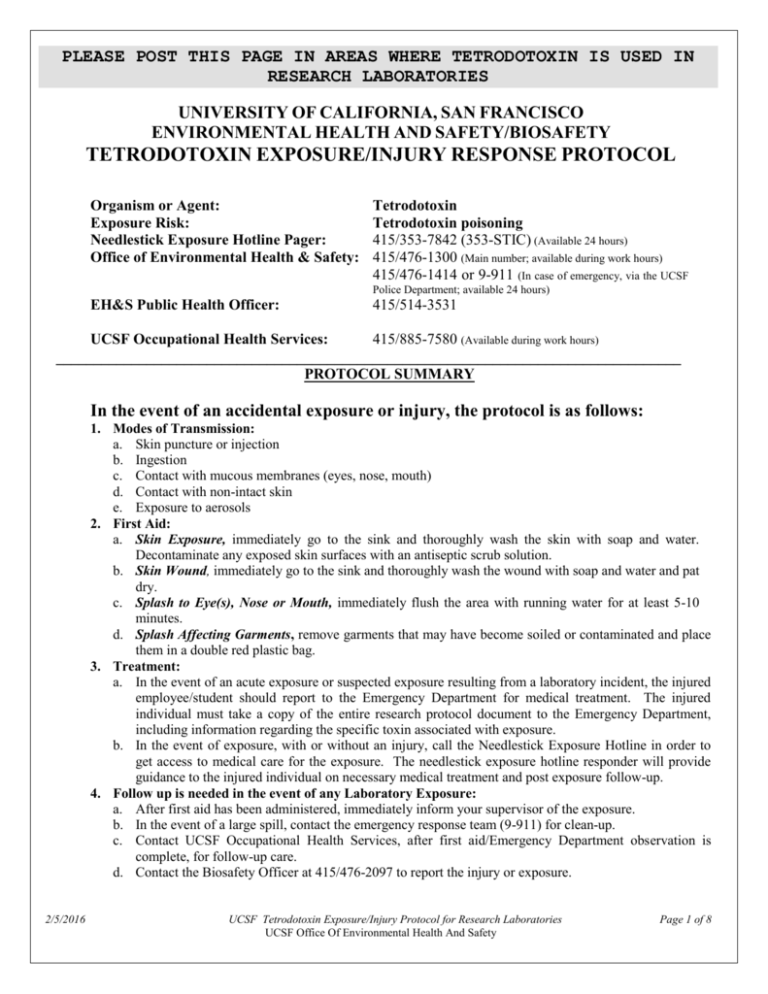
PLEASE POST THIS PAGE IN AREAS WHERE TETRODOTOXIN IS USED IN RESEARCH LABORATORIES UNIVERSITY OF CALIFORNIA, SAN FRANCISCO ENVIRONMENTAL HEALTH AND SAFETY/BIOSAFETY TETRODOTOXIN EXPOSURE/INJURY RESPONSE PROTOCOL Organism or Agent: Exposure Risk: Needlestick Exposure Hotline Pager: Office of Environmental Health & Safety: Tetrodotoxin Tetrodotoxin poisoning 415/353-7842 (353-STIC) (Available 24 hours) 415/476-1300 (Main number; available during work hours) 415/476-1414 or 9-911 (In case of emergency, via the UCSF Police Department; available 24 hours) EH&S Public Health Officer: 415/514-3531 UCSF Occupational Health Services: 415/885-7580 (Available during work hours) ___________________________________________________________________________________ PROTOCOL SUMMARY In the event of an accidental exposure or injury, the protocol is as follows: 1. Modes of Transmission: a. Skin puncture or injection b. Ingestion c. Contact with mucous membranes (eyes, nose, mouth) d. Contact with non-intact skin e. Exposure to aerosols 2. First Aid: a. Skin Exposure, immediately go to the sink and thoroughly wash the skin with soap and water. Decontaminate any exposed skin surfaces with an antiseptic scrub solution. b. Skin Wound, immediately go to the sink and thoroughly wash the wound with soap and water and pat dry. c. Splash to Eye(s), Nose or Mouth, immediately flush the area with running water for at least 5-10 minutes. d. Splash Affecting Garments, remove garments that may have become soiled or contaminated and place them in a double red plastic bag. 3. Treatment: a. In the event of an acute exposure or suspected exposure resulting from a laboratory incident, the injured employee/student should report to the Emergency Department for medical treatment. The injured individual must take a copy of the entire research protocol document to the Emergency Department, including information regarding the specific toxin associated with exposure. b. In the event of exposure, with or without an injury, call the Needlestick Exposure Hotline in order to get access to medical care for the exposure. The needlestick exposure hotline responder will provide guidance to the injured individual on necessary medical treatment and post exposure follow-up. 4. Follow up is needed in the event of any Laboratory Exposure: a. After first aid has been administered, immediately inform your supervisor of the exposure. b. In the event of a large spill, contact the emergency response team (9-911) for clean-up. c. Contact UCSF Occupational Health Services, after first aid/Emergency Department observation is complete, for follow-up care. d. Contact the Biosafety Officer at 415/476-2097 to report the injury or exposure. 2/5/2016 UCSF Tetrodotoxin Exposure/Injury Protocol for Research Laboratories UCSF Office Of Environmental Health And Safety Page 1 of 8 ROLES & RESPONSIBILITIES AFTER ACCIDENTAL EXPOSURE TO TETRODOTOXIN 1. WORKER’S RESPONSIBILITIES (Employee/Student Initial Self-Care) a. First Aid: Perform the recommended first aid and decontamination according to the posted instructions. b. Treatment: i. In the event of an exposure resulting from a laboratory incident, the exposed individual should report to the Emergency Department for acute medical treatment. The onset of symptoms may be rapid, ii. In the event of an exposure, with or without an injury, call the Needlestick Exposure Hotline in order to get access to medical care for the exposure and evaluation for possible post exposure prophylaxis. c. Access to Needlestick Hotline: Immediately, call the Needlestick Exposure Hotline in the event of an exposure. Dial 415 /353-7842. However, the first priority should be reporting to the nearest emergency room with a copy of this protocol. d. Reporting: Inform your laboratory supervisor / principal investigator of the exposure. e. Secure the laboratory: Identify the equipment involved in the exposure and the mechanism of exposure. Make sure that the laboratory area has been secured and that notification of contamination has been posted to prevent other individuals from entering the area. f. Follow up: Contact Occupational Health Services (OHS) at 415 / 885-7580 for follow up care. 2. SUPERVISOR’S/PI’S RESPONSIBILITIES a. First Aid and Decontamination: Verify that the worker has washed and decontaminated himself/herself. Ensure that appropriate medical treatment has been received. b. Secure the laboratory: Confirm that the laboratory area has been secured and that notification of contamination has been posted to prevent other individuals from entering the area. c. Laboratory clean-up (as needed): Contact the Office of Environmental Health & Safety (OEH&S) through the UC Police Department Emergency Dispatch (from a campus telephone 9-911, from a noncampus phone 415/476-1414). d. Report the exposure: Call the Biosafety officer during regular hours to discuss the exposure. A report summarizing any suspected tetrodotoxin exposure needs to be submitted to the Biosafety Committee by the Principal Investigator (PI). The report must include the following: A brief description of the exposure event, a description of the area involved, and the extent of employee exposure If applicable, specification of the amount of toxic material released, time involved, and explanation of procedures used to determine the amount involved Corrective action taken to prevent the re-occurrence of the incident Any decontamination procedures e. Follow Up: Confirm that the worker has called for an appointment at the UCSF Occupational Health Clinic. f. 2/5/2016 Report the Injury: Within 24 hours, report the injury to the UCSF Human Resources Disability Management Services (HR DMS) Office on the Supervisor’s Report of Injury (SRI) form, available here: http://ucsfhr.ucsf.edu/dismgmt/forms/workcomp/claim/SRI.pdf UCSF Tetrodotoxin Exposure/Injury Protocol for Research Laboratories UCSF Office Of Environmental Health And Safety Page 2 of 8 UNIVERSITY OF CALIFORNIA SAN FRANCISCO ENVIRONMENTAL HEALTH AND SAFETY TOXIC SUBSTANCE DATA SHEET TETRODOTOXIN FOR USE IN RESEARCH LABORATORIES SECTION I – Toxic Agent Organism or Agent: Tetrodotoxin Synonym or Cross Reference: Fugu poisoning, Spheroidine, Tarichatoxin, Tetradotoxin, Tetrodontoxin, Tetrodotoxine, Tetrodoxin, TTX Characteristics: Colorless or white crystalline solid or powder that darkens when heated above 428°F (220°C). Found in a variety of fish and amphibians, including the California newt. The toxin is probably produced by bacteria. Vibrio alginolyticus is frequently found in marine vertebrates that contain tetrodotoxin.¹ SECTION II – Recommended Precautions Containment Requirements: Biosafety level 2 practices, safety equipment and facilities for specimens or cultures known or suspected to contain the agent. ABSL-2 practices, containment equipment and facilities for activities involving experimentally or naturally infected animals. UCSF Required Personal Protective Equipment: Non-permeable nitrile or latex gloves. Disposable long-sleeved lab coat. Safety glasses or goggles. Wear N-95 respirator when handling stock powder SECTION III – Handling Information Spills: Allow aerosols to settle; wearing protective clothing, gently cover spill with paper towel and apply 1% sodium hypochlorite, starting at perimeter and working towards the center; allow at least 30 minutes of contact time before clean up. Disposal: Decontaminate before disposal. Storage: Store in sealed containers that are appropriately labeled. SECTION IV – Health Hazards Pathogenicity: Tetrodotoxin is an extremely potent poison found mainly in the liver and sex organs (gonads) of some fish, such as puffer fish, globefish, and toadfish (order Tetraodontiformes) and in some amphibian, octopus, and shellfish species. Human poisonings commonly occur when the flesh and/or organs of the fish are improperly prepared and eaten. A natural or synthetic form may be used in research laboratories; exposure in the laboratory setting has similar characteristics as natural exposure. Tetrodotoxin interferes with the transmission of signals from nerves to muscles and causes an increasing paralysis of the muscles of the body. Tetrodotoxin poisoning can be fatal. Epidemiology: No data exists on laboratory tetrodotoxin poisoning. Fugu poisoning from eating contaminated fish can be fatal in up to 60% of exposures, depending on the amount of toxin ingested. Host Range: NA. Toxic Dose: A dose of approximately 10 /kg is thought to be a serious toxic dose for humans based on extrapolated animal data. The mouse LD50 dose is 334 /kg.¹ Rat LD50 is 8-10 g/kg Modes of Transmission: Usually through ingestion, but inhalation and percutaneous exposure can result in poisoning. Time to onset of symptoms: Varies depending on dose. Onset of lip tingling may occur within 10 minutes. Symptoms generally occur within minutes to hours. Death occurs within the first 6 to 24 hours. Prognosis is good if the patient survives the first 24 hours.¹ 2/5/2016 UCSF Tetrodotoxin Exposure/Injury Protocol for Research Laboratories UCSF Office Of Environmental Health And Safety Page 3 of 8 Acute Symptoms: Hypothermia, hypotension due to vasodilatation, bradycardia, dysrythmias, and asystole can occur. Hypertension has been reported. Nausea, vomiting, diarrhea, salivation and diaphoresis may occur. Vertigo, dizziness, headache and blurred vision are common. Generalized weakness in the limbs with ascending onset, paresthesias (especially peri-oral), ataxia and areflexia may occur. Victims may appear comatose with pinpoint or dilated fixed pupils, but they are actually completely aware as long as ventilation is provided. Death usually is caused by respiratory depression and respiratory muscle paralysis.¹ FOR THE USE OF THE NEEDLESTICK EXPOSURE HOTLINE SECTION V – Viability Drug Susceptibility: NA. Physical Inactivation: Not susceptible to steam autoclaving. Dry heat above 260 degrees C for 10 minutes inactivates over 99% of the toxin. SECTION VI – Medical Surveillance: Tetrodotoxin is a small organic molecule that acts directly on the sodium channel of nerve tissue. All observed effects are secondary to the sodium channel blockade; tetrodotoxin acts on both the central and peripheral nervous systems. Peripheral nervous system blockade results in an increasing paralysis of the muscular system; central nervous system blockade results in direct respiratory system suppression. Onset of symptoms may be as rapid as 15 – 45 minutes after exposure, or as long as 3-6 hours, but rarely longer. Death may occur as early as 20 minutes or as late as 24 hours after exposure, but usually within the first 4-6 hours. Prognosis is good with intensive care treatment, and if the exposed victim survives the first 24 hours.¹ Patients who survive exposure to tetrodotoxin usually recover without residual deficits. First Aid/Treatment: No specific treatment; care is supportive. Availability of timely endotracheal intubation and mechanical ventilation is crucial. Immunization: None available Prophylaxis: None Reporting: Any known cases of food borne tetrodotoxin exposure must be reported to local and federal authorities but accidental laboratory exposures are not reportable. SECTION VII – Laboratory Hazards Laboratory-Acquired Poisoning: Not a common laboratory-associated poisoning. Sources/Specimen: Tissues of the puffer fish and some other marine animals; most toxin used in the research laboratory is synthetic. Primary Hazards: Experimentally poisoned animals are not a risk factor to laboratory workers; ingestion is the common mode of exposure; however parenteral inoculation, ingestion, and exposure to aerosols are also possible routes of laboratory exposure. Special Hazards: None FOR THE USE OF THE EMERGENCY DEPARTMENT SECTION VIII – Emergency Medical Treatment Symptoms: The onset of symptoms may occur within minutes after exposure, and the disease may progress rapidly. Assess the severity of the exposure, and take appropriate supportive actions. Treatment Indications: Emergency department assessment, observation and supportive treatment are crucial. Emergency Department consultation with California Poison Control Center Personnel is recommended. Care for other concomitant injuries may also be required. Treatment needs to consist of the following: 1) decontamination and debridement, 2) wound repair, 3) monitoring until adequate time 2/5/2016 UCSF Tetrodotoxin Exposure/Injury Protocol for Research Laboratories UCSF Office Of Environmental Health And Safety Page 4 of 8 passes to assure safety, 4) endotracheal intubation as needed for respiratory support, and other supportive measures as indicated, and 5) follow up with UCSF-OHS. Exposure Indications: In the event of an exposure, with or without an injury, the Needlestick Exposure Hotline should be called. Decontamination: Ensure that the wound or exposure site has been adequately decontaminated. Followup: Provide a sufficient period of observation such that the need for respiratory support is deemed extremely unlikely. Any patient seen in the Emergency Department and released should be given information about the potential for delayed onset of symptoms/toxicity. Any symptoms would be reason for emergent reevaluation, but would not be expected more than 24 hours after exposure. Any exposed individuals should also be referred to the UCSF Occupational Health Services for follow-up care (Format/Content adapted directly from the MSDS supplied by Sigma-Aldrich, Tocris, and Alomone Labs; and the 5th Edition of Biosafety in Microbiological and Biomedical Laboratories (BMBL) with additional information from subsequent portions of the protocol) SECTION VIII – References 1. Information taken directly from Poisindex 2. 5th Edition of Biosafety in Microbiological and Biomedical Laboratories (BMBL) 2/5/2016 UCSF Tetrodotoxin Exposure/Injury Protocol for Research Laboratories UCSF Office Of Environmental Health And Safety Page 5 of 8 UNIVERSITY OF CALIFORNIA SAN FRANCISCO ENVIRONMENTAL HEALTH AND SAFETY/BIOSAFETY TETRODOTOXIN EXPOSURE PROTOCOL REFERENCE INFORMATION/BACKGROUND FOR LABORATORY WORKERS I. RISKS IN LABORATORY WORKERS/CLINICAL SUMMARY FOR DEFENSES IN THE NATURAL WORLD, EVOLUTION HAS FAVORED RAPILDY ACTING TOXINS, ESPECIALLY FOR SLOW OR SEDENTARY ANIMALS THAT DEPEND ON TOXINS FOR DEFENSE. THE SODIUM CHANEL IS THE PRIMARY SITE FOR ACTION OF THESE FAST ACTING TOXINS. TETRODOTOXIN IS FAMOUS FOR ITS POTENT, RAPID, AND HIGHLY SPECIFIC ACTION IN BLOCKING ACTION POTENTIALS IN NERVE CELLS.² 2/5/2016 There have been few documented laboratory acquired poisonings. Although most human tetrodotoxin poisoning is food borne, other modes of exposure may occur in the laboratory setting. Tetrodotoxin is a small organic molecule that acts directly on the sodium channel of nerve tissue. Specific data are not available, but mortality from food borne tetrodotoxin poisoning is estimated to be 13 to 60%.¹ All observed effects are secondary to the sodium channel blockade; tetrodotoxin acts on both the central and peripheral nervous systems. Peripheral nervous system blockade results in an increasing paralysis of the muscular system; central nervous system blockade results in direct respiratory system suppression. Onset of symptoms may be as rapid as 15 – 45 minutes after exposure, or as long as 3-6 hours, but rarely longer. Death may occur as early as 20 minutes or as late as 24 hours after exposure, but usually within the first 4-6 hours. Prognosis is good with intensive care treatment, and if the exposed victim survives the first 24 hours.¹ Patients who survive exposure to tetrodotoxin usually recover without residual deficits. Analysis of food borne exposures demonstrates that most deaths occur when emergency treatment and supportive care are not readily available or sought. Early symptoms are lip and tongue paresthesias followed by facial and extremity paresthesias and numbness. Salivation, nausea, vomiting, and diarrhea with abdominal pain develop early Motor dysfunction with weakness, hypoventilation (may be from dysfunction of central and peripheral nervous systems), and speech difficulties then develop. A rapid ascending paralysis occurs over 4-24 hours. Finally, cardiac dysfunction with hypotension and bradycardia, central nervous system dysfunction, and seizures develop. Patients with severe toxicity may have deep coma, fixed nonreactive pupils, apnea, and loss of all brain stem reflexes. Death can occur within 4-6 hours. Typically, death occurs from respiratory muscle paralysis and respiratory failure. Laboratory workers should be extremely diligent in the practice of hand hygiene. Whenever gloves are removed, laboratory workers should always wash their hands. UCSF Tetrodotoxin Exposure/Injury Protocol for Research Laboratories UCSF Office Of Environmental Health And Safety Page 6 of 8 1. Poisondex 2. Guidebook to Protein Toxins and Their Use in Cell Biology. Edited by Rino Rappuoli and Cesare Montecucco. Oxford University Press, 1997. 3. Chowdury F R et. al. Singapore Med J 2007; 48 (9) : 830 4. Am J Emerg Med. 2003; 21(1):51-4 (ISSN: 0735-6757) 5. eMedicine.com: tetrodotoxin toxicity. 2/5/2016 UCSF Tetrodotoxin Exposure/Injury Protocol for Research Laboratories UCSF Office Of Environmental Health And Safety Page 7 of 8 II. CDC/NIH RECOMMENDATIONS FOR LABORATORY EXPOSURE TO TETRODOTOXIN OCCUPATIONAL POISONINGS Occupational poisoning generally occurs only in the setting of research laboratory workers who work directly with the toxin and are exposed accidentally, although secondary accidental exposure is possible if proper handling and cleaning precautions are not observed. NATURAL MODES OF POISONING Most human cases of tetrodotoxin poising result from eating contaminated foods, notably tissues of the puffer fish (fugu) or the blue-ringed octopus. Poisoning with tetrodotoxin presents first within 15 minutes to several hours with numbness of the mouth and lips, followed by numbness of the face and extremities. Respiratory failure, through respiratory muscle paralysis may occur within 4 to 6 hours. The outcome is usually favorable with supportive care. LABORATORY SAFETY Tetrodotoxin is usually found in the laboratory only in manufactured vials. Agent Summary Statements – Biological Agents While inhalation is the most common route of exposure in the laboratory, tetrodotoxin can also cause poisoning through accidental ingestion, inoculation, or mucous membrane exposure. Containment Recommendations BSL-2 practices, containment equipment, and facilities are recommended when working with clinical specimens and cultures known or suspected to contain the agent. Gloves and eye protection should be worn while handling materials containing the toxin. ABSL-2 practices, containment equipment and facilities are recommended for activities involving experimentally or naturally poisoned animals or tissues. The above paragraph taken directly from: http://www.cdc.gov/OD/ohs/biosfty/bmbl5/bmbl5toc.htm III. REFERENCES: Tetrodotoxin References Please see individual sections above and: 1. www.cdc.gov/niosh/ershdb/EmergencyResponseCard_29750019.html 2/5/2016 UCSF Tetrodotoxin Exposure/Injury Protocol for Research Laboratories UCSF Office Of Environmental Health And Safety Page 8 of 8
